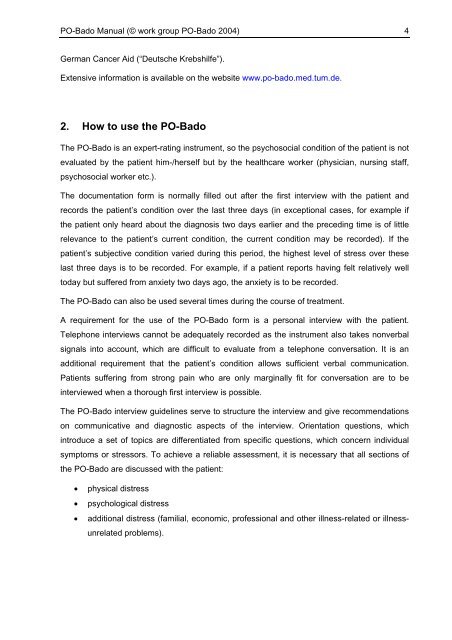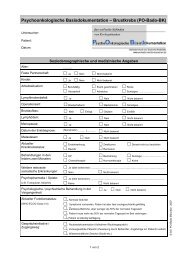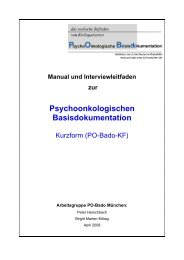PO-Bado Manual (2 - PO-Bado - TUM
PO-Bado Manual (2 - PO-Bado - TUM
PO-Bado Manual (2 - PO-Bado - TUM
You also want an ePaper? Increase the reach of your titles
YUMPU automatically turns print PDFs into web optimized ePapers that Google loves.
<strong>PO</strong>-<strong>Bado</strong> <strong>Manual</strong> (© work group <strong>PO</strong>-<strong>Bado</strong> 2004) 4<br />
German Cancer Aid (“Deutsche Krebshilfe”).<br />
Extensive information is available on the website www.po-bado.med.tum.de.<br />
2. How to use the <strong>PO</strong>-<strong>Bado</strong><br />
The <strong>PO</strong>-<strong>Bado</strong> is an expert-rating instrument, so the psychosocial condition of the patient is not<br />
evaluated by the patient him-/herself but by the healthcare worker (physician, nursing staff,<br />
psychosocial worker etc.).<br />
The documentation form is normally filled out after the first interview with the patient and<br />
records the patient’s condition over the last three days (in exceptional cases, for example if<br />
the patient only heard about the diagnosis two days earlier and the preceding time is of little<br />
relevance to the patient’s current condition, the current condition may be recorded). If the<br />
patient’s subjective condition varied during this period, the highest level of stress over these<br />
last three days is to be recorded. For example, if a patient reports having felt relatively well<br />
today but suffered from anxiety two days ago, the anxiety is to be recorded.<br />
The <strong>PO</strong>-<strong>Bado</strong> can also be used several times during the course of treatment.<br />
A requirement for the use of the <strong>PO</strong>-<strong>Bado</strong> form is a personal interview with the patient.<br />
Telephone interviews cannot be adequately recorded as the instrument also takes nonverbal<br />
signals into account, which are difficult to evaluate from a telephone conversation. It is an<br />
additional requirement that the patient’s condition allows sufficient verbal communication.<br />
Patients suffering from strong pain who are only marginally fit for conversation are to be<br />
interviewed when a thorough first interview is possible.<br />
The <strong>PO</strong>-<strong>Bado</strong> interview guidelines serve to structure the interview and give recommendations<br />
on communicative and diagnostic aspects of the interview. Orientation questions, which<br />
introduce a set of topics are differentiated from specific questions, which concern individual<br />
symptoms or stressors. To achieve a reliable assessment, it is necessary that all sections of<br />
the <strong>PO</strong>-<strong>Bado</strong> are discussed with the patient:<br />
• physical distress<br />
• psychological distress<br />
• additional distress (familial, economic, professional and other illness-related or illnessunrelated<br />
problems).








